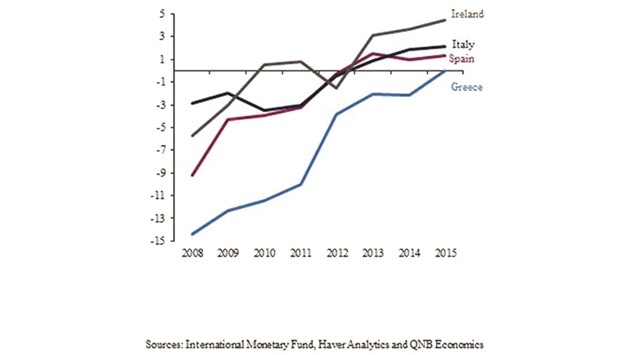Growth in the euro area was stabilising, showing that the worst of the crisis was probably behind the region, QNB has said in a report.
In its ‘economic commentary’ QNB said growth in the euro area was stronger than expected in the first quarter of 2016, registering 2.2% on an annualised basis. While the full data are yet to become available, early signs indicate strong growth in the European periphery such as Ireland and Spain. This suggests that at least part of the region’s crisis is over.
“But there is still some way to go for the region,” QNB said.
Although growth for the year 2016 is expected to stabilise, it is settling at the rather unimpressive rate of 1.5%. Furthermore, if any negative shock hit the economy, there would be limited policy space to respond, especially on the monetary side.
Growth in the euro area beat expectations by around 0.6%. But the overall better-than-expected performance hides regional variation in growth among euro area countries.
Germany continues to show steady growth, with analysts expecting around 2.4% growth in Q1.
Meanwhile, Spain and Ireland are the standout performers, with the former growing by 3.2% in the first quarter, and the latter growing by 7.8% in 2015 (Q1 data are not available yet).
The stellar performance of some periphery countries shows that at least some adjustment has actually taken place in the euro area. Indeed, most periphery countries have managed to turn their large current account deficits, one of the major causes of the euro area crisis in 2011-12, into surpluses as they successfully regained competitiveness.
This was achieved through both the reduction of domestic costs and wages in the periphery countries as well as the depreciation of the euro, which improved the external balances of the region as a whole.
Despite the correction of the external imbalances, growth in the region is expected to stabilise in 2016 at 1.5%, similar to the rate achieved last year as some tailwinds are offset by headwinds.
On the one hand, lower oil prices this year should support consumption in the region given that it is a net oil importer. In addition, both monetary and fiscal policies are expected to continue to be supportive for growth.
On the other hand, and despite accommodative monetary policy, its impact is becoming more limited. Furthermore, the uncertainty surrounding potential UK exit from the European Union (Brexit) is hindering growth in the region, although to a lesser extent than its impact on the UK.
While growth is expected to stabilise, the region also faces a number of risks. On the domestic front, there is the risk of other countries seeking an exit from the European Union or the euro area if Brexit succeeds.
There is also the risk of spillover from Greece if the annual round of negotiations over debt fails to reach an agreement. The region also faces a number of external risks such as a disruptive slowdown in the Chinese economy or a derailing of the recovery in the US.
If these risks materialise, there will be limited policy space to respond. On the monetary side, there is little the central bank could do having already reduced interest rates to negative and embarked on a large quantitative easing programme.
This leaves fiscal policy to do the heavy lifting, but even this is constrained by the high level of public debt, which is currently around 93% of GDP, QNB said.
“In summary, growth in the euro area is stabilising, showing that the worst of the crisis is probably behind the region.
However, it is settling at a rather unimpressive rate. And if the region is hit by an adverse shock, either domestic or external, then the policy space to respond is limited—especially on the monetary front,” QNB said.

GROWTH


